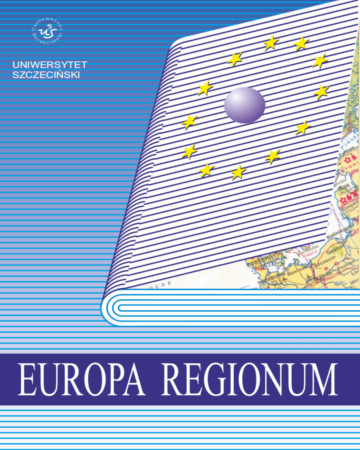
ISSN: 1428-278X
OAI
DOI: 10.18276/er.2017.33-06


Issue archive /
t. 33 2017
WPŁYW FUNDUSZY UNII EUROPEJSKIEJ NA POZYCJĘ INNOWACYJNOŚCI I KONKURENCYJNOŚCI POLSKICH PRZEDSIĘBIORSTW
(Effects of European Union funds on innovate position and of polish enterprises)
| Authors: |
Katarzyna
Łukaszewska
Uniwersytet Ekonomiczny w Poznaniu Wydział Ekonomii |
| Keywords: | innovation level of innovation EU funds program POIR |
| Data publikacji całości: | 2017-12-31 |
| Page range: | 12 (59-70) |
| Klasyfikacja JEL: | D22 G20 O31 |
Abstract
Article’s goal is to verify if the EU funds for Polish innovation activities have been put through within the position of the Polish entrepreneurships in the innovation and competitiveness ranking among chosen EU countries. The direction and extent of the EU assistance in the field of Polish enterprises innovation will be presented based on the example of the Innovative Economy Programme, which was the largest programme supporting the enterprises innovation in the 2007–2013 perspective. Methods of deduction and induction, as well as, comparative analysis and document analysis have been used in this article. Private entrepreneurs’ funds have been the main source of innovation funding for many years now. However, during the 2010–2014 period a very tangible tendency was observed – a decrease in innovation’s financing with private funds was substituted with international sources. During the 2007–2013 period, the general value of innovative projects constituted only of 23,51% of all enterprises’ investment projects. The EU funding of those projects was approximately 16,68 billion zloty’s during that time. Innovations are the main subject of the European Union business programmes aimed at entrepreneurs. The most popular encouraging innovativeness programme was the Innovative Economy Programme. Having invested similar amount of funds into innovative projects, large entrepreneurships received funding from the EU assets, which were lowered by 10 percentage points than the entrepreneurships from the SMEs sector. The financial help guaranteed by the European Union did not influence Poland’s position in the European Union’s enterprises innovation ranking but it could have influenced the increase of patent applications which were filed to the European Patent Office as well as improve the rate of Poland’s competitiveness in 2007–2016 period.
Download file
Article file
Bibliography
| 1. | Czarnota, A. (2009). Wpływ innowacji na konkurencyjność przedsiębiorstwa. Zeszyty Naukowe Wydziału Nauk Ekonomicznych Politechniki Koszalińskiej, 13 (1), 81–91. |
| 2. | European Commision. Pobrane z: http://ec.europa.eu/growth/industry/innovation/facts-figures/scoreboards_en (15.10.2017). |
| 3. | Europejski Urząd Patentowy. Social Reports for the year 2007–2016. Pobrane z: https:// |
| 4. | www.epo.org/about-us/annual-reports-statistics/social-reports.html (11.10.2017). |
| 5. | Jankowska, A., Malik, R., Wosiek, R., Domańska, A. (2017). Innowacyjność i konkurencyjność międzynarodowa: nowe wyzwania dla przedsiębiorczości i państwa. Warszawa: SGH. |
| 6. | Kokot-Stępień, P. (2016). Finansowanie działalności innowacyjnej przedsiębiorstw w Polsce. Zeszyty Naukowe Politechniki Częstochowskiej. Zarządzanie, 24 (1), 16–29. |
| 7. | Łączak, A. (2015). Fundusze UE jako źródła finansowania innowacji w przedsiębiorstwach oraz efektywność ich wykorzystania w Polsce w latach 2004–2013. Pobrane z: http://kolegia.sgh.waw.pl/pl/KZiF/struktura/IF/konferencje/Documents/A_Laczak.pdfkolegia.sgh.waw.pl (15.10.2017). |
| 8. | Mazur-Wierzbicka, E. (2015). Działalność innowacyjna przedsiębiorstw w Polsce. Zeszyty Naukowe Małopolskiej Wyższej Szkoły Ekonomicznej w Tarnowie, 26 (1), 97–99. |
| 9. | Mądra, J. (2013). Bariery innowacyjności przedsiębiorstwa z sektora MSP. W: Konferencja Innowacje w Zarządzaniu i Inżynierii Produkcji Zakopane 2013. Artykuły (s. 202–204). Opole: Oficyna Wydawnicza Polskiego Towarzystwa Zarządzania Produkcją. |
| 10. | Ministerstwo Rozwoju Regionalnego. Szczegółowy opis priorytetów Programu Operacyjnego Innowacyjna Gospodarka, 2007–2013, Warszawa, 2013. Pobrane z: https://www.poig.2007-2013.gov.pl/.../SZOP_POIG_ver%2017_27062013.pdf (8.10.2017 ). |
| 11. | Ministerstwo Rozwoju. Dowiedz się więcej o Funduszach Europejskich. Pobrane z: https://www.mr.gov.pl/strony/zadania/fundusze-europejskie/dowiedz-sie-wiecej-o-funduszach-europejskich/ (8.10.2017). |
| 12. | Ministerstwo Rozwoju. Sprawozdanie Końcowe z Realizacji Programu Operacyjnego Innowacyjna Gospodarka 2007–2013, Warszawa, 2015. Pobrane z: https://www.poig.2007-2013.gov.pl/Wiadomosci/Strony/Innowacyjna_Gospodarka_efekty_podsumowania_220317.aspx (11.10.2017). |
| 13. | Ministerstwo Rozwoju. Szczegółowy opis priorytetów Programu Operacyjnego Innowacyjna Gospodarka, 2007–2013. Warszawa, 2013. |
| 14. | Portal innowacji. Pobrane z:http://www.pi.gov.pl/PARP/chapter_86197.asp?soid=2AEEACE-070E74DF1A2103D50A087765C, 2010 (1.10.2017). |
| 15. | Rutkowska-Gurak, A. (2010). W poszukiwaniu miar innowacyjności rozwoju. Acta Universitatis Lodziensis, Folia Oeconomica, 246, 65–67. |
| 16. | Targalski, J. (2014). Przedsiębiorczość i zarządzanie małym i średnim przedsiębiorstwem. Warszawa: Difin. |
| 17. | World Economic Forum, Global Competitiveness Reports, 2010–2017. Pobrane z: https://www.weforum.org/reports/the-global-competitiveness-report-2016-2017-1 (4.10.2017). |